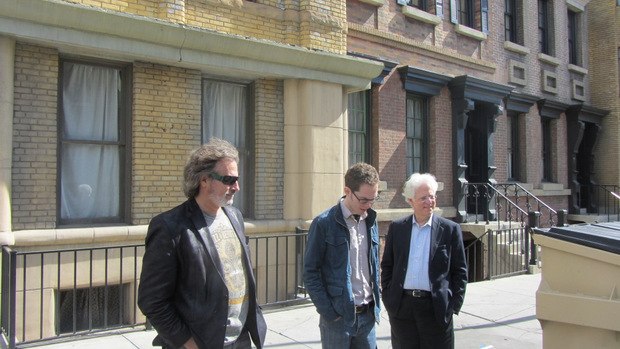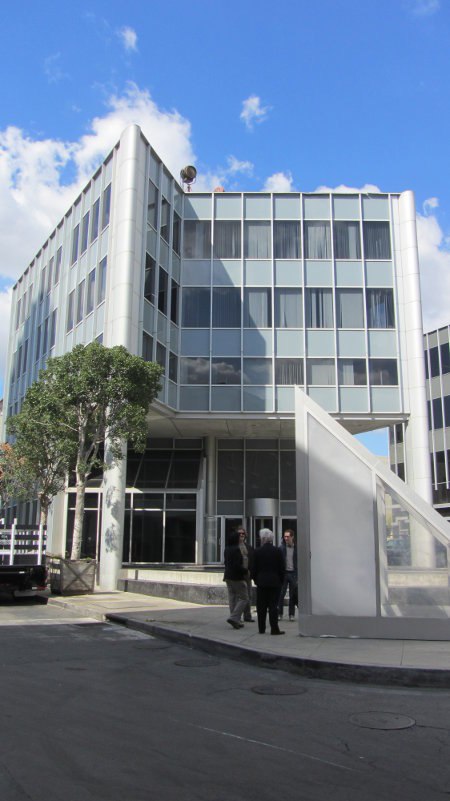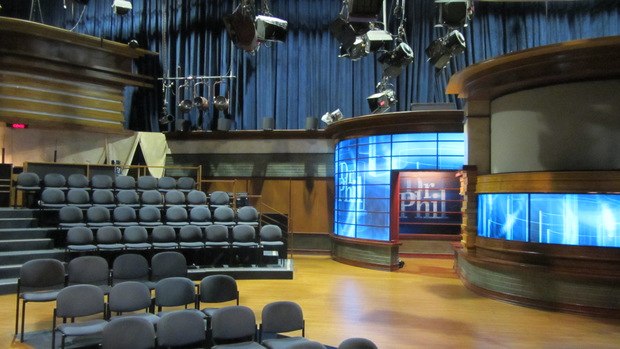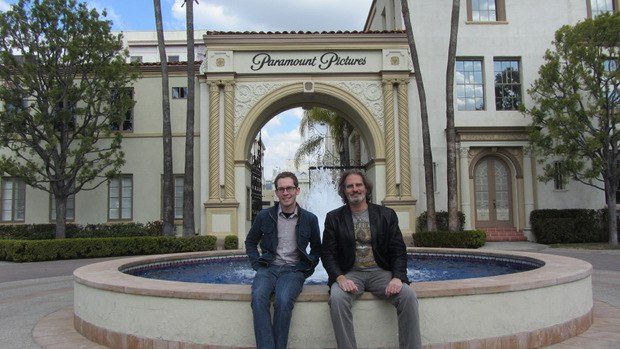Day 4 of the LA leg concludes at Paramount.
By Dan Sarto
Our Paramount Tour started with coffee and sunglasses, our group basking in the welcome warmth of the sun after having spent the last few days in the cold, wind and sporadic Southern California drizzle. Like Sony and Fox, Paramount is a huge studio, complete with large soundstages and even larger cinematic and television history. As our electric cart motored off, our tour guide expertly peppered us with interesting studio facts and a brief rundown of some of the classic films made here at the studio.
We stopped at one point to take a picture with the iconic Hollywood sign balanced on the hills far behind us. We drove past huge sound stages and production buildings, as well as a New York backlot that like Fox, you’ve seen in more shows and commercials then you realize.
Some of our backlot highlights:
- We came up on the oldDesilu Studios office compound, built on the old RKO Studios lot owned byHoward Hughes, where Lucile Ball had a large courtyard built up like herbackyard so she could give press interviews and make audiences think shewas actually at home. The idea of a hard working “mother” as a studioexecutive was an idea not yet that palatable to the masses. Tents and other campground items weresetup on the grassy area. Ronquickly announced we’d stumbled upon Occupy Paramount.
- At the corner of thatgrassy area, our guide pointed out the handprints and signatures of TedDanson and Woody Harrelson, who had been drinking one night in 1989 andended up running around the lot naked before arriving at that very spot,which housed a section of wet cement. The two, on the lot shooting their show Cheers, are immortalized there in the cement. Woody wrote (naked) in parenthesis nextto his handprints. I quickly jokedthat my dad once knew a man with five penises. The group looked at me. I finishedquickly by saying, “His pants fit him like a glove.” More stares. Ronthought it was funny.
- David stood up and posedon top of a retaining wall bordering a parking lot that doubles as a750,000 gallon lake, used on a number of films including The Truman Show.
- We walked through the Dr.Phil Show set. I left the building feeling surprisingly refreshed andfeeling better about myself.
We finished out tour with some pictures at the Bronson gate, then headed over to the screening for Q&A.
David was asked what it was like leaving and then coming back to The Simpsons. He replied that he was gone from 1998-2002. Coming back, he felt comfortable with most everything. He came back initially as a consultant on storyboards, but soon was asked to direct. He also spoke about how more recently, one big change has been that since The Simpsons Movie in 2007, the studio has digitized their entire production pipeline through the implementation of Cintiq tablets and Toon Boom Studio software, which has greatly enabled the creative process. He explained that they used to layout entire episodes and if you didn’t like something, you had to throw out reams of animation. That’s not the case anymore.
Tim was asked what inspired him to make his film and he explained how he went to the UK, had a long distance relationship, was inspired by Rembrandt’s Philosopher in Meditation, wondered about relationships between vastly different people, and came up with the idea of the two worlds separated by reverse gravity.
Bob Bacon, executive vice president of production at Paramount Animation, asked David about the decision not to use dialogue.
David replied, “At dinner last night, I was chatting with Brad Bird. He of course was involved with The Simpsons at the very beginning. He told me he was at a story meeting once where they had this notion of Maggie escaping from a daycare center. I didn’t know anything about this. I guess in some ways that idea was revived, although it [our short film idea] came out of a meeting, so it might just have been serendipity. We had a meeting in 2011 with Jim Brooks. We had been fooling around with 3D using some existing animation, just trying it out. Jim said he wanted to do a short, to try something silent. We’d explored a little bit of pantomime with The Simpsons certainly. Well, silent meant Maggie. We also said it should be from her perspective, which meant a daycare center. So we pulled the Ayn Rand Daycare Center out of an old episode, A Streetcar Name Marge.”
When Tim was asked about his voice casting and recording for the “hmmms” and other people noises of his characters, he recalled a funny story from production. “The guy who did the voice for the husband did not know how to hock a loogie [laughter]. He was this old British voice actor. I said, ‘OK, now you hock a loogie. Do you know what I mean by that?’ He said, ‘No.’ I explained it’s like spitting, like clearing your throat and spitting. He couldn’t do it. I had to walk him through the process. ‘Do you know how to make a sound like someone shooting a gun? Ppppeeow ppppeeow. No just get rid of the P and hold it longer.’”
David was asked about the 3D aspect of his short. Developing a 3D pipeline, he explained, was not the only reason for making the film but was certainly a contributing factor. He also explained that originally, he was asked to keep the film at two and a half minutes, which was impossible given the amount of story to be told. It ended up at four and half minutes.
Someone asked the filmmakers if they had found themselves at any point with too much story and if so, how did they handle the decision on how to cut down or otherwise alter their films. Tim explained that his ending was the first story piece he came up with. It was an obvious decision not to alter it, which he never did. David mentioned how Matt had made a note early on that he felt they should bring Homer in at the end and show more of Marge. But, he said, they decided to take a Tom & Jerry approach where the adults were rarely seen. Also, he said originally, they were going to open with the Atlas Shrugged statue, which you end up barely seeing in the final film. The original ending had Marge bringing Maggie to the car as the butterfly flies off her head. Homer is waiting in the car. They get in the car and then Homer backs up into the statue accidentally. As they drive off, the globe Atlas was holding has fallen off and is chasing them.
The Q&A wrapped up, which meant it was lunch time. Bob as well as Annie Laks, vice president of production, Jill Gilbert, vice president of animation and several other executives joined us for a great meal. If you recall from our lunch here last year, they have pretzel rolls. Far from me to shift my focus from any business lunch discussions, but for a few moments, between my Diet Coke and pretzel roll slathered in butter, I was at peace with the world. Just as fleeting as the moment appeared, it slipped away. Back to the business of trying to sound like I know what I’m talking about, never an easy task.
Lunch conversation was lively, as we talked about recent animated features, development hell and difficulties inherent in animated feature film marketing. Annie gave us all a great lesson in film audience tracking numbers and how they affect, among other things, the number of screens a film will be given in its theatrical release.
Time came to head out. I think the nominees were looking forward to a bit of a rest before the Feature Film Symposium later that night as well as our final tour day Friday at DreamWorks and Disney Television, followed by the Acme – AWN Oscar Party. We bid adieu and headed out into the late afternoon sun.
Dan Sarto is Publisher and Editor-in-Chief of Animation World Network.















